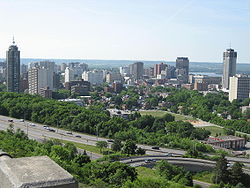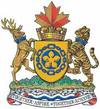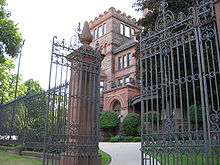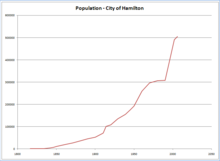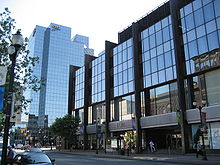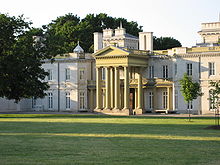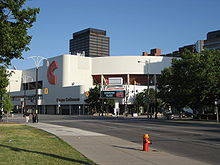- Hamilton, Ontario
-
For Hamilton Township in Northumberland County, see Hamilton, Ontario (township).
Hamilton — City — City of Hamilton 
Flag
Coat of armsNickname(s): Ambitious City,[1] Steeltown,[2] The Hammer[3] Motto: Together Aspire - Together Achieve Location in the province of Ontario, Canada Coordinates: 43°15′N 79°52′W / 43.25°N 79.867°WCoordinates: 43°15′N 79°52′W / 43.25°N 79.867°W Country  Canada
CanadaProvince  Ontario
OntarioIncorporated June 9, 1846[4] Government – Mayor Bob Bratina – City Council Hamilton City Council – MPs List of MPs– MPPs List of MPPsArea[5] – City 1,138.11 km2 (439.4 sq mi) – Land 1,117.11 km2 (431.3 sq mi) – Water 21 km2 (8.1 sq mi) – Urban 227.70 km2 (87.9 sq mi) – Metro 1,371.76 km2 (529.6 sq mi) Highest elevation 324 m (1,063 ft) Lowest elevation 75 m (246 ft) Population (2006)[5][6] – City 504,559 (9th) – Density 451.6/km2 (1,169.6/sq mi) – Urban 647,634 – Metro 692,911 (9th) – Demonym Hamiltonian Time zone EST (UTC-5) – Summer (DST) EDT (UTC-4) Postal code span L8E to L8W, L9A to L9C, L9G to L9H, L9K Area code(s) 905, 289 Website www.hamilton.ca Hamilton (
 /ˈhæməltən/; 2006 population 504,559; UA population 647,634; CMA population 692,911) is a port city in the Canadian province of Ontario. Conceived by George Hamilton when he purchased the Durand farm shortly after the War of 1812,[7] Hamilton has become the centre of a densely populated and industrialized region at the west end of Lake Ontario known as the Golden Horseshoe. On January 1, 2001, the new City of Hamilton was formed through the amalgamation of the former city and the other constituent lower-tier municipalities of the Regional Municipality of Hamilton-Wentworth with the upper-tier regional government.[8] Residents of the old city are known as Hamiltonians.[9] Since 1981, the metropolitan area has been listed as the ninth largest in Canada and the third largest in Ontario.
/ˈhæməltən/; 2006 population 504,559; UA population 647,634; CMA population 692,911) is a port city in the Canadian province of Ontario. Conceived by George Hamilton when he purchased the Durand farm shortly after the War of 1812,[7] Hamilton has become the centre of a densely populated and industrialized region at the west end of Lake Ontario known as the Golden Horseshoe. On January 1, 2001, the new City of Hamilton was formed through the amalgamation of the former city and the other constituent lower-tier municipalities of the Regional Municipality of Hamilton-Wentworth with the upper-tier regional government.[8] Residents of the old city are known as Hamiltonians.[9] Since 1981, the metropolitan area has been listed as the ninth largest in Canada and the third largest in Ontario.Hamilton is home to the shared Royal Botanical Gardens, the Canadian Warplane Heritage Museum, the Bruce Trail, McMaster University and Mohawk College. The Canadian Football Hall of Fame can be found downtown right beside Hamilton City Hall and across town to the east, the Canadian Football League's Hamilton Tiger-Cats play at Ivor Wynne Stadium.
Partly because of its diverse environment, numerous TV and film productions have been filmed in Hamilton, regulated by the Hamilton Film and Television Office.[10] A growing arts and culture sector garnered media attention in a 2006 Globe and Mail news article, entitled "Go West, Young Artist," which focused on the growing art scene in Hamilton. The article highlighted local art galleries, recording studios and independent film production.[11]
Contents
History
Main article: History of Hamilton, OntarioIn pre-colonial times, the Neutral Indians used much of the land but were gradually driven out by the Five (later Six) Nations (Iroquois) who were allied with the British against the Huron and their French allies. A member of the Iroquois Confederacy provided the route and name for Mohawk Road, which originally included King street in the lower city. In 1784, about 10,000 United Empire Loyalists settled in Upper Canada (what is now southern Ontario), chiefly in Niagara, around the Bay of Quinte, and along the St. Lawrence River between Lake Ontario and Montreal. They were soon followed by many more Americans, some of them not so much ardent loyalists but attracted nonetheless by the availability of inexpensive, arable land. At the same time, large numbers of Iroquois loyal to Britain arrived from the United States and were settled on reserves west of Lake Ontario.[12]
The town of Hamilton was conceived by George Hamilton (a son of a Queenston entrepreneur and founder, Robert Hamilton), when he purchased farm holdings of James Durand, the local Member of the British Legislative Assembly, shortly after the War of 1812.[7] Nathaniel Hughson, a property owner to the north, cooperated with George Hamilton to prepare a proposal for a courthouse and jail on Hamilton's property. Hamilton offered the land to the crown for the future site. Durand was empowered by Hughson and Hamilton to sell property holdings which later became the site of the town. As he had been instructed, Durand circulated the offers at York during a session of the Legislative Assembly and a new Gore District was established of which the Hamilton town site was a member.[7]
Initially, this town was not the most important centre of the Gore District. A permanent jail was not constructed until 1832 when a cut-stone design was completed on one of the two squares created in 1816, Prince's Square.[7] Subsequently, the first police board and the town limits were defined by statute on February 13, 1833.[13] Official City status was achieved on June 9, 1846, by an act of Parliament, 9 Victoria Chapter 73.[4]
As the city grew, several prominent buildings were constructed in the late 19th century, including the Grand Lodge of Canada in 1855,[14] West Flamboro Methodist Church in 1879 (later purchased by Dufferin Masonic Lodge in 1893[15]), a public library in 1890, and the Right House department store in 1893. The first commercial telephone service in Canada, the first telephone exchange in the British Empire, and the second telephone exchange in all of North America all were established in the city between 1877–78.[16]
Though suffering through the Hamilton Street Railway strike of 1906, with industrial businesses expanding, Hamilton's population doubled between 1900 and 1914. Two steel manufacturing companies, Stelco and Dofasco, were formed in 1910 and 1912, respectively, and Procter & Gamble and the Beech-Nut Packing Company opened manufacturing plants in 1914 and 1922, respectively, their first outside the US.[17] Population and economic growth continued until the 1960s, with the 1929 construction of the city's first high-rise building, the Pigott Building, the move of McMaster University from Toronto to Hamilton, the opening of the second Canadian Tire store in Canada in 1934, an airport in 1940, a Studebaker assembly line in 1948,[18] the Burlington Bay James N. Allan Skyway in 1958, and the first Tim Hortons store in 1964. Since then, many of the large industries have moved or shut down operations[17] and the economy has shifted more toward the service sector, such as transportation, education, and health services.
On January 1, 2001, the new city of Hamilton was formed from the forced amalgamation of the Regional Municipality of Hamilton-Wentworth and its six municipalities: Ancaster, Dundas, Flamborough, Glanbrook, and Stoney Creek.[8] Before amalgamation, the "old" City of Hamilton had 331,121 Hamiltonians divided into 100 neighbourhoods. The new amalgamated city has 490,268 people in over 100 old neighbourhoods, and surrounding communities.[19]
Geography
Main article: Geography of Hamilton, OntarioHamilton is located in Southern Ontario on the western end of the Niagara Peninsula and wraps around the westernmost part of Lake Ontario; most of the city, including the downtown section, is on the south shore. Hamilton is situated in the geographic centre of the Golden Horseshoe and is roughly the midway point between Toronto and Buffalo, New York. Its major physical features are Hamilton Harbour, marking the northern limit of the city, and the Niagara Escarpment running through the middle of the city across its entire breadth, bisecting the city into 'upper' and 'lower' parts.[20]
According to all records from local historians, this district was called "Attiwandaronia" by the native Neutral people.[21] The first aboriginals to settle in the Hamilton area called the bay Macassa, meaning beautiful waters.[19] Hamilton is one of 11 cities showcased in the book, "Green City: People, Nature & Urban Places" by Quebec author Mary Soderstrom, which examines the city as an example of an industrial powerhouse co-existing with nature.[22] Soderstrom credits Thomas McQuesten and family in the 1930s who "became champions of parks, greenspace and roads" in Hamilton.[23]
Burlington Bay is a natural harbour with a large sandbar called the Beachstrip. This sandbar was deposited during a period of higher lake levels during the last ice age, and extends southeast through the central lower city to the escarpment. Hamilton's deep sea port is accessed by ship canal through the beach strip into the harbour and is traversed by two bridges, the QEW's Burlington Bay James N. Allan Skyway and the lower Canal Lift Bridge.[24]
Panoramic view of Hamilton Harbour from T.B. McQuesten High Level Bridge on York Boulevard, near Harvey Park.
Between 1788 and 1793, the townships at the Head-of-the-Lake were surveyed and named. The area was first known as The Head-of-the-Lake for its location at the western end of Lake Ontario.[16] John Ryckman, born in Barton township (where present day downtown Hamilton is), described the area in 1803 as he remembered it: "The city in 1803 was all forest. The shores of the bay were difficult to reach or see because they were hidden by a thick, almost impenetrable mass of trees and undergrowth...Bears ate pigs, so settlers warred on bears. Wolves gobbled sheep and geese, so they hunted and trapped wolves. They also held organized raids on rattlesnakes on the mountainside. There was plenty of game. Many a time have I seen (sic) a deer jump the fence into my back yard, and there were millions of pigeons which we clubbed as they flew low."[25] Webster's Falls at Spencer Gorge / Webster's Falls Conservation Area
Webster's Falls at Spencer Gorge / Webster's Falls Conservation Area
George Hamilton, a settler and local politician, established a town site in the northern portion of Barton Township in 1815. He kept several east–west roads which were originally Indian trails, but the north–south streets were on a regular grid pattern. Streets were designated "East" or "West" if they crossed James Street or Highway 6. Streets were designated "North" or "South" if they crossed King Street or Highway 8.[26] The overall design of the townsite, likely conceived in 1816, was commonplace. George Hamilton employed a grid street pattern used in most towns in Upper Canada and throughout the American frontier. The eighty original lots had frontages of fifty feet; each lot faced a broad street and backed onto a twelve foot lane. It took at least a decade for all of the original lots to be sold, but the construction of the Burlington Canal in 1823, and a new court-house in 1827, encouraged Hamilton to add more blocks around 1828–9. At this time, he included a market square in an effort to draw commercial activity onto his lands, but the natural growth of the town was to the north of Hamilton's plot.[27]
The Hamilton Conservation Authority owns, leases or manages about 4,500 hectares (11,100 acres) of land with the City operating 1,077 hectares (2,661 acres) of parkland at 310 locations.[28][29] Many of the parks are located along the Niagara Escarpment, which runs from Tobermory at the tip of the Bruce Peninsula in the north, to Queenston at the Niagara River in the south, and provides views of the cities and towns at the western end of Lake Ontario. The hiking path Bruce Trail runs the length of the escarpment.[30] Hamilton is home to more than 100 waterfalls and cascades, most of which are on or near the Bruce Trail as it winds through the Niagara Escarpment.[31]
Panoramic view of lower Hamilton from Sam Lawrence Park near Concession Street on the Niagara Escarpment (Hamilton mountain).
Climate
Hamilton's climate is humid-continental, characterized by changeable weather patterns. However, its climate is moderate compared with most of Canada. Hamilton's location on an embayment at the southwestern corner of Lake Ontario with an escarpment dividing upper and lower parts of the city results in noticeable disparities in weather over short distances. With a July average of exactly 22.0 °C (71.6 °F),[32] the lower city is located in a pocket of the Dfa climate zone found at the southwestern end of Lake Ontario (between Hamilton and Toronto and eastward into the Niagara Region) , while the upper reaches of the city fall into the Dfb climate zone.
The airport's open, rural location and higher altitude (240m vs. 85m ASL downtown) results in lower temperatures and higher snowfall amounts than the more sheltered and lower, built-up areas of the city. One exception is on early spring afternoons, when colder than air lake temperatures keep shoreline areas significantly cooler, under the presence of an east or north-east onshore flow.
Climate data for Hamilton RBG Month Jan Feb Mar Apr May Jun Jul Aug Sep Oct Nov Dec Year Record high °C (°F) 14.5
(58.1)16.7
(62.1)25.0
(77.0)31.0
(87.8)35.0
(95.0)36.5
(97.7)38.8
(101.8)37.8
(100.0)37.8
(100.0)32.2
(90.0)26.2
(79.2)21.2
(70.2)38.8
(101.8)Average high °C (°F) −1.1
(30.0)−0.4
(31.3)4.6
(40.3)11.5
(52.7)18.5
(65.3)24.1
(75.4)27.3
(81.1)25.9
(78.6)21.3
(70.3)14.4
(57.9)7.7
(45.9)1.8
(35.2)13.0 Daily mean °C (°F) −5
(23)−4.4
(24.1)0.5
(32.9)6.9
(44.4)13.3
(55.9)18.8
(65.8)22
(72)20.9
(69.6)16.4
(61.5)10
(50)4.2
(39.6)−1.6
(29.1)8.5 Average low °C (°F) −8.8
(16.2)−8.3
(17.1)−3.6
(25.5)3.2
(37.8)8.0
(46.4)13.4
(56.1)16.6
(61.9)15.9
(60.6)11.6
(52.9)5.6
(42.1)0.6
(33.1)−5
(23.0)4.0 Record low °C (°F) −28.3
(−18.9)−26.2
(−15.2)−21.7
(−7.1)−12.2
(10.0)−2
(28.4)2.2
(36.0)7.2
(45.0)3.6
(38.5)−0.7
(30.7)−6.1
(21.0)−14.4
(6.1)−25.7
(−14.3)−28.3
(−18.9)Precipitation mm (inches) 59.5
(2.343)55.0
(2.165)75.7
(2.98)73.5
(2.894)81.8
(3.22)71.6
(2.819)74.9
(2.949)84.6
(3.331)84.9
(3.343)72.5
(2.854)81.5
(3.209)77.1
(3.035)892.6
(35.142)Rainfall mm (inches) 27.9
(1.098)26.6
(1.047)53.4
(2.102)68.6
(2.701)81.8
(3.22)71.6
(2.819)74.9
(2.949)84.6
(3.331)84.9
(3.343)72.4
(2.85)73.8
(2.906)48.0
(1.89)768.5
(30.256)Snowfall cm (inches) 35.0
(13.78)29.1
(11.46)20.0
(7.87)4.7
(1.85)0
(0)0
(0)0
(0)0
(0)0
(0)0
(0)7.2
(2.83)30.1
(11.85)126.1
(49.65)Avg. precipitation days 15.1 12.4 12.5 12.8 11.8 10.6 10.7 10.7 11.7 11.7 13.6 14.5 148.1 Avg. rainy days 5.5 4.7 8.9 11.7 11.8 10.6 10.7 10.7 11.7 11.7 12.1 7.8 117.9 Avg. snowy days 11.1 9.0 5.1 1.5 0 0 0 0 0 0 2.5 8.9 38.1 Sunshine hours 90 111.4 146.3 186.7 243.1 271.6 299.7 259.8 176.6 144.2 86.5 71.7 2,087.5 Source: Environment Canada [32] Demographics
According to the 2006 Canadian Census, more than 20 percent of the local population was not born in Canada. This is the third highest such proportion in Canada after Toronto at 49%, and Vancouver at 39%. Between 2001 and 2006, the foreign-born population increased by 7.7% while the total population of the Hamilton census metropolitan area (CMA) grew by 4.3%. The share of Canada's recent immigrants who settle in Hamilton has remained unchanged since 2001 at 1.9%. Hamilton was home to 20,800 immigrants who arrived in Canada between 2001 and 2006, half of whom were born in Asia and the Middle East, while nearly one-quarter (23%) were from Europe. Hamilton also had a high proportion of people with Italian, English, Scottish, German and Irish ancestry. Nearly three in ten residents reported English as their sole ethnic origin or as one of their ancestral origins. As well, nearly one in five reported Scottish ancestry either alone or in combination with another ethnic origin.[35]
The top countries of birth for the newcomers living in Hamilton in the 1990s were: former Yugoslavia, Poland, India, China, the Philippines, and Iraq.[36] The city proper of Hamilton was home to 67,845 visible minorities in 2006, representing 13.6% of its population, up from 10.9% in 2001.[37] Visible minorities comprised 22.8% of Ontario's population, primarily due to high proportions in Toronto.[38] The population is 84.8% White, 3.0% South Asian/East Indian, 2.8% Black, 1.9% Chinese, 1.5% Aboriginal, 1.2% Southeast Asian, 1.1% Latin American, 1.1% Arab, 0.8% Filipino, and 1.8% Other.[39]
Children aged 14 years and under accounted for 17.8% of the population while those 65 years of age and older constituted 14.9%, resulting in an average age of 39.6 years.[37]
The most described religion in Hamilton is Christianity although other religions brought by immigrants are also growing. The 2001 census indicates that 77.6% of the population adheres to a Christian denomination, Protestants constituting 37.1% of the population, while Catholics number 35.5% (significantly lower than the national average) with Christ the King Cathedral as the seat of the Diocese of Hamilton. The remaining 5.0% consists of Orthodox and independent Christian churches. The largest non-Christian religion is Islam with 12,880 adherents or 2.0% of the total population. Other religions, including Judaism, Buddhism, Jainism and Hinduism, constitute less than one percent each. Those with no religious affiliation accounted for 115,510 (17.6%) in 2001.[40]
Environics Analytics, a geodemographic marketing firm that created 66 different "clusters" of people complete with profiles of how they live, what they think and what they consume, sees a future Hamilton with younger upscale Hamiltonians—who are tech savvy and university educated—choosing to live in the downtown and surrounding areas rather than just visiting intermittently. More two and three storey townhouses and apartments will be built on downtown lots; small condos will be built on vacant spaces in areas such as Dundas and Westdale to accommodate newly retired seniors; and more retail and commercial zones will be created. The city is also expected to grow by more than 28,000 people and 18,000 households by the year 2012.[41]
Reported ethnic origins, 2006 Ethnic origin Population[42] Percent[note 1] English 138,125 27.9 Canadian 107,780 21.7 Scottish 98,375 19.8 Irish 80,740 16.2 Italian 58,800 11.8 German 47,960 9.6 Reported ethnic origins, 2006 Ethnic origin Population Percent French 42,070 8.5 Polish 27,775 5.6 Dutch 25,720 5.2 Ukrainian 18,730 3.8 Portuguese 14,115 2.8 North American Indian 11,970 2.4 - ^ Note that a person may report more than one ethnic origin.
Economy
Main article: Economy of Hamilton, OntarioLloyd D. Jackson Square (Mall), Commerce Place Complex
The most important economic activity in Ontario is manufacturing, and the Toronto–Hamilton region is the most highly industrialized section of the country. The area from Oshawa, Ontario around the west end of Lake Ontario to Niagara Falls, with Hamilton at its centre, is known as the Golden Horseshoe and has a population of approximately 8.1 million people.[43] The phrase was first used by Westinghouse President, Herbert H. Rogge, in a speech to the Hamilton Chamber of Commerce, on January 12, 1954. "Hamilton in 50 years will be the forward cleat in a golden horseshoe of industrial development from Oshawa to the Niagara River...150 miles long and 50 miles (80 km) wide...It will run from Niagara Falls on the south to about Oshawa on the north and take in numerous cities and towns already there, including Hamilton and Toronto."[44]
With sixty percent of Canada's steel being produced in Hamilton by Stelco and Dofasco, the city has become known as the Steel Capital of Canada.[45] After nearly declaring bankruptcy, Stelco returned to profitability in 2004[46] and on August 26, 2007 United States Steel Corporation acquired Stelco for C$38.50 in cash per share, owning more than 76 percent of Stelco's outstanding shares.[47] Dofasco, in 1999, was the most profitable steel producer in North America and in 2000, the most profitable in Canada. It currently has approximately 7,300 employees at its Hamilton plant and produces over four million tons of steel annually, representing about 30% of Canada's flat rolled sheet steel shipments. Dofasco is one of North America's most profitable steel companies, and Dofasco was named to the Dow Jones Sustainability World Index in 2006 for the seventh year in a row. Dofasco produces steel products for the automotive, construction, energy, manufacturing, pipe and tube, appliance, packaging and steel distribution industries.[48] Dofasco is currently a stand alone subsidiary of Arcelor Mittal, the world's largest steel producer. Previously ordered by the U.S. Department of Justice to divest itself of the Canadian company, Arcelor Mittal has now been allowed to retain Dofasco provided it sells several of its American assets instead.[49]
Originally, in the 1940s, the John C. Munro Hamilton International Airport was used as a wartime air force training station. Today TradePort International Corporation manages and operates the John C. Munro Hamilton International Airport. Under TradePort management, passenger traffic at the Hamilton terminal has increased from 90,000 in 1996 to approximately 900,000 in 2002. The airport's mid-term target for growth in its passenger service is five million air travelers annually. The air cargo sector of the airport has 24-7 operational capability and strategic geographic location, allowing its capacity to increase by 50% since 1996; 91,000 metric tonnes (100,000 tons) of cargo passed through the airport in 2002. Courier companies with operations at the airport include United Parcel Service and Cargojet Canada.[50] In 2003, the city began developing a 30-year growth management strategy which called, in part, for a massive aerotropolis industrial park centred around Hamilton Airport. The aerotropolis proposal, now known as the Airport Employment Growth District, is touted as a solution to the city's shortage of employment lands.[51] Hamilton turned over operation of the airport to TradePort International Corp. in 1996. In 2007, YVR Airport Services (YVRAS), which runs the Vancouver International Airport, took over 100 per cent ownership of TradePort in a $13-million deal. The airport is also home to the Canadian Warplane Heritage Museum.
A report by Hemson Consulting identified an opportunity to develop 1,000 hectares (2,500 acres) of greenfields (the size of the Royal Botanical Gardens) that could generate an estimated 90,000 jobs by 2031. A proposed aerotropolis industrial park at Highway 6 and 403, has been debated at City Hall for years. Opponents feel the city needs to do more investigation about the cost to taxpayers before embarking on the project.[52]
Government
Main article: Politics of Hamilton, OntarioSee also: Hamilton City Council and Category:Mayors of Hamilton, OntarioMain article: Hamilton, Ontario municipal election, 2010Citizens of Hamilton are represented by three tiers of government. The federal representation consists of five members of parliament serving in the Parliament of Canada for the federal ridings of Ancaster—Dundas—Flamborough—Westdale, Hamilton Centre, Hamilton East—Stoney Creek, Hamilton Mountain, and Niagara West—Glanbrook. At the provincial tier, there are five elected members who serve in the Legislature of Ontario for the provincial ridings of Ancaster—Dundas—Flamborough—Westdale, Hamilton Centre, Hamilton East—Stoney Creek, Hamilton Mountain, and Niagara West—Glanbrook. The municipal tier consists of one mayor, elected city wide, and 15 city councillors, elected individually by each of the 15 ward divisions, to serve on the Hamilton City Council. Additionally, at the municipal tier, each ward elects a school board trustee for each of the school boards serving in their respective area.
Municipal elections in Hamilton occur every four years, the last one falling on October 25, 2010. The next election will occur on October 27, 2014.
The Hamilton City Council is granted authority to govern by the province through the Municipal Act of Ontario.[53] The Province of Ontario has supervisory privilege over the municipality and the power to redefine, restrict or expand the powers of all municipalities in Ontario. Further, the province provides oversight of Hamilton City Council through the Ontario Municipal Board.
The Criminal Code of Canada is the chief piece of legislation defining criminal conduct and penalty. The Hamilton Police Service is chiefly responsible for the enforcement of federal and provincial law. Although the Hamilton Police Service has authority to enforce, bylaws passed by the Hamilton City Council are mainly enforced by Provincial Offences Officers[54] employed by the City of Hamilton.
There is a strong military presence in Hamilton, with the John Weir Foote Armoury located in the downtown on James Street North, housing the Royal Hamilton Light Infantry as well as the 11th Field Hamilton-Wentworth Battery and the Argyll and Sutherland Highlanders of Canada. The Hamilton Reserve Barracks, located on Pier Nine, houses the naval reserve division HMCS Star, 23 Service Battalion and the 23 Field Ambulance.
Education
Hamilton is home to several post-secondary institutions that have created numerous direct and indirect jobs in education and research. McMaster University moved to the city in 1930 and today has over 22,000 enrolled students, of whom almost two-thirds come from outside the immediate Hamilton region.[55][56] Brock University of St. Catharines, Ontario has a satellite campus used primarily for teacher education located in Hamilton.[57] Colleges in Hamilton include:
- McMaster Divinity College, a Christian seminary affiliated with the Baptist Convention of Ontario and Quebec since 1957. McMaster Divinity College is located on the McMaster University campus, and is affiliated with the University. The Divinity College was created as part of the process of passing governance of the University as a whole from the BCOQ to a privately chartered, publicly funded arrangement.
- Mohawk College, a college of applied arts and technology since 1967 with 10,000 full time, 40,000 part time, and 3,000 apprentice students.[58]
- Columbia International College is Canada's largest private boarding university-preparatory school, with over 1,300 students from over 60 countries.[59]
- Redeemer University College, a private Christian liberal arts and science university opened in 1982, with about 800 students currently.[60]
Public education for students from kindergarten through high school is administered by three school boards. The Hamilton-Wentworth District School Board manages 114 public schools[61], while the Hamilton-Wentworth Catholic District School Board operates 55 schools in the greater Hamilton area.[62] The Conseil scolaire de district du Centre-Sud-Ouest operates one elementary and one secondary school (École secondaire Georges-P.-Vanier), and the Conseil scolaire de district catholique Centre-Sud operates two elementary schools and one secondary school. Calvin Christian School and Timothy Christian are private Christian elementary schools. Hamilton District Christian High School (HDCH), Rehoboth Christian High School and Guido de Bres Christian High School are private Christian high schools in the area. Hillfield Strathallan College is located on the West Hamilton mountain and is a CAIS member, non-profit school for children from early Montessori ages through grade twelve.
The Dundas Valley School of Art is an independent art school which has serviced the Hamilton region since 1964. Students range in age from 4 years old to senior citizens and enrollment as of February 2007 was close to 4,000. In 1998, a new full time diploma programme was launched as a joint venture with McMaster University. The faculty and staff are highly regarded regional artists.[63]
The Hamilton Conservatory for the Arts is home to many of the area's talented young actors, dancers, musicians, singers and visual artists. The school is equipped with a keyboard studio, spacious dance studios, art and sculpting studios, gallery space and a 300 seat recital hall. HCA offers over 90 programs for ages 3–93, creating a “united nations” of arts under one roof.[64]
The Hamilton Literacy Council is a non-profit organization that provides basic (grade 1 - 5 equivalent) training in reading, writing, and math to English-speaking adults. The council's service is free, private, and one-to-one. It started to assist adults with their literacy skills in 1973.
Hamilton is home to two think tanks, the Centre for Cultural Renewal and Cardus, which deals with social architecture, culture, urbanology, economics and education and also publishes the LexView Policy Journal and Comment Magazine.[65]
Culture
Main article: Culture of Hamilton, OntarioSee also: Media in Hamilton, Ontario and People from Hamilton, OntarioHamilton has built on its historical and social background with attractions including the Canadian Warplane Heritage Museum, the HMCS Haida National Historic Site (Canada's most famous warship and the last remaining Tribal Class in the world),[66] Dundurn Castle (the residence of a Prime Minister of Upper Canada),[67] the Royal Botanical Gardens, the Canadian Football Hall of Fame, the African Lion Safari park, the Cathedral of Christ the King, and the Workers Arts and Heritage Centre. [68]
Founded in 1914, the Art Gallery of Hamilton is Ontario's third largest public art gallery. The Gallery has over 9,000 works in its permanent collection that focus on three areas: 19th-century European, Historical Canadian and Contemporary Canadian.[69]
The McMaster Museum of Art, founded on campus in 1967, houses McMaster University’s collection of more than 6,000 works of art, including exhibitions on the historical and contemporary work and the Herman Levy collection of Impressionist painting.[70]
Growth in the arts and culture sector has garnered high level media attention for Hamilton. A Globe and Mail article in 2006, entitled "Go West, Young Artist," focused on the growing art scene in Hamilton.[11] The Factory: Hamilton Media Arts Centre,[71] opened up a new home on James Street North in 2006. Art galleries are springing up on many streets across the City: James Street, Locke Street and King Street, to name a few. This, coupled with growth in the downtown condo market which is drawing people back to the core, is having an impact on the cultural fabric of the city. The opening of the Downtown Arts Centre[72] on Rebecca Street has spurred further creative activities in the core. The Community Centre for Media Arts[73] (CCMA) continues to operate in downtown Hamilton. The CCMA works with marginalized populations and combines new media services such as website development, graphic design, video, and information technology, with arts education and skills development programming.[74]
The 2009 film Defendor, starring Woody Harrelson as a vigilante superhero, is implied to take place in Hamilton, referred to by its nickname of "Hammer Town" several times throughout the film. It was filmed in Hamilton and Toronto.
Sports
Main article: Sports in Hamilton, OntarioSee also: List of sports venues in Hamilton, Ontario and Category:Sport in Hamilton, OntarioCopps Coliseum, York Boulevard, looking East
 The Canadian Football Hall of Fame museum
The Canadian Football Hall of Fame museum
Professional teams Club League Venue Established Championships Hamilton Tiger-Cats Canadian Football League Ivor Wynne Stadium 1950[75] 15 Hamilton Bulldogs American Hockey League Copps Coliseum 1996 1 Amateur and junior clubs Club League Venue Established Championships Hamilton Avalanche W-League of the United Soccer Leagues Brian Timmis Stadium 2006 0 Hamilton Croatia Canadian Soccer League Brian Timmis Stadium 1957 1 Hamilton FC Rage Premier Development League Brian Timmis Stadium 2010 0 Hamilton Red Wings Ontario Provincial Junior A Hockey Dave Andreychuk Mountain Arena 1973 1 Hamilton Hornets R.F.C. Niagara Rugby Union Mohawk Sports Park 1954 0 Hamilton Wildcats Australian Rules Football League Mohawk Sports Park 1997 0 Hamilton Thunderbirds Inter County Baseball League Bernie Arbour Memorial Stadium 2005 0 Hamilton was the host of Canada's first major international athletic event, the first Commonwealth Games (then called the British Empire Games) in 1930. Hamilton bid unsuccessfully for the Commonwealth Games in 2010, losing out to New Delhi in India.[76] On November 7, 2009, in Guadalajara, Mexico it was announced that Toronto will host the 2015 Pan Am Games after beating out two rival South American cities, Lima, Peru and Bogota, Colombia. The city of Hamilton will be co-hosting the Games with Toronto. Hamilton Mayor Fred Eisenberger said "the Pan Am Games will provide a 'unique opportunity for Hamilton to renew major sport facilities giving Hamiltonians a multi-purpose stadium, a 50 metre swimming pool, and an international-calibre velodrome to enjoy for generations to come.'"[77]
The Around the Bay Road Race circumnavigates Hamilton Harbour or Burlington Bay. Although it is not a marathon distance, it is the longest continuously held long distance foot race in North America.[2] The local newspaper also hosts the amateur Spectator Indoor Games.[2]
Hamilton has representation in two professional sports leagues, the Canadian Football League and the American Hockey League. Its major sports complexes include Ivor Wynne Stadium and Copps Coliseum; Hamilton is also home to the Canadian Football Hall of Fame museum.[78] The museum hosts an annual induction event in a week long celebration that includes school visits, a golf tournament, a formal induction dinner and concludes with the Hall of Fame game involving the local CFL Hamilton Tiger-Cats at Ivor Wynne Stadium.[79][80]
In addition to team sports, Hamilton is also home to an auto race track, Flamboro Speedway and Canada's fastest half-mile harness horse racing track, Flamboro Downs.[81] Another auto race track, Cayuga International Speedway, is located near Hamilton in the Haldimand County community of Nelles Corners, situated between Hagersville and Cayuga.[82]
Hamilton hosted an NHL team in the 1920s called the Hamilton Tigers. The team folded after a players' strike in 1925.[83] Research in Motion CEO Jim Balsillie has shown interest in bringing another NHL team to southern Ontario. The NHL's Phoenix Coyotes filed for bankruptcy in 2009 and have included within their Chapter 11 reorganization a plan to sell the team to Balsillie and move the team and its operations to Hamilton, Ontario.[84] In late September, however, the bankruptcy judge did not rule in favor of Balsillie. The City plans to continue their fight for an NHL team.
Notable people
Main article: List of people from Hamilton, Ontario- Eugene Levy, CM - Actor, comedian, television director, producer, musician, and writer.
- Karen Kain, CC - Retired ballet dancer, and currently the Artistic Director of the National Ballet of Canada.
- Martin Short, CM - Actor, comedian, writer, singer and producer.
- Neil Peart, OC - Musician and author. He is the drummer for the rock band Rush.
- Toller Cranston, CM - Figure skater and painter.
Sister cities
Hamilton is a sister city with Flint, Michigan, and its young amateur athletes compete in the Canusa Games, held alternatively in the two cities since 1958.[76] Flint and Hamilton hold the distinction of having the oldest continuous sister-city relationship between a U.S. and Canadian city, since 1957.[85]
Sister cities with Hamilton include:[86]
Other city relationships:[86]
See also
- Metrolinx
- Greater Toronto and Hamilton Area
- Hamilton ravine system
References
- ^ Bailey, Thomas Melville (1991). Dictionary of Hamilton Biography (Vol II, 1876-1924). W.L. Griffin Ltd.
- ^ a b c "Tigertown Triumphs" (Press release). The Hamilton Spectator - Memory Project (Souvenir Edition) page MP56-MP68. 2006-06-10.
- ^ "Don't put The Hammer down; Hamilton's had lots of nicknames, but this one's like the city -- no pretence," Paul Wilson, Hamilton Spectator, December 6, 2006, p. G2.
- ^ a b Provincial Statutes of Canada 1846 9° vict. pg 981 Chapter LXXIII. An Act to amend the Act incorporating the Town of Hamilton, and to erect the same into a City.
- ^ a b "Community Highlights for Hamilton (City)". 2001 Canadian Census. Statistics Canada. http://www12.statcan.ca/english/Profil01/CP01/Details/Page.cfm?Lang=E&Geo1=CSD&Code1=3525005&Geo2=PR&Code2=35&Data=Count&SearchText=hamilton&SearchType=Begins&SearchPR=01&B1=All. Retrieved 2008-01-04.
- ^ "Stats Canada 2006 Canadian Census: Hamilton, Ontario". Statistics Canada. http://www12.statcan.ca/english/census06/data/profiles/community/Details/Page.cfm?Lang=E&Geo1=CSD&Code1=3525005&Geo2=PR&Code2=35&Data=Count&SearchText=Hamilton&SearchType=Begins&SearchPR=01&B1=All&Custom=. Retrieved 2008-01-04.
- ^ a b c d Weaver, John C. (1985). Hamilton: an illustrated history. James Lorimer & Company, Publishers. pp. 15–16. ISBN 0-88862-593-6 cloth.
- ^ a b "City of Hamilton Act, 1999". http://www.e-laws.gov.on.ca/html/statutes/english/elaws_statutes_99c14c_e.htm#BK6. Retrieved 2008-01-04.
- ^ Houghton, Margaret (2003). The Hamiltonians, 100 Fascinating Lives. James Lorimer & Company Ltd., Publishers Toronto. p. 6. ISBN 1-55028-804-0.
- ^ "Reel Choices: Film production resource guide" (PDF). City of Hamilton. http://www.myhamilton.ca/NR/rdonlyres/28A1218B-C9A4-4941-A57D-3E69C261C14F/0/FilmGuideLines.pdf. Retrieved 2008-01-04.
- ^ a b Mowat, Bruce (January 6, 2007). "Go west, young artist". Globe and Mail.
- ^ Mackenzie, Ann. "A Short History of the United Empire Loyalists" (PDF). United Empire Loyalists' Association of Canada. http://www.uelac.org/PDF/loyalist.pdf. Retrieved 2008-01-04.
- ^ Statutes of Upper Canada, 1833 3° William IV pg. 58-68. Chapter XVII An act to define the Limits of the Town of Hamilton, in the District of Gore, and to establish a Police and Public Market therein.
- ^ "A Brief History of Grand Lodge of Canada in the Province of Ontario:1855 ~ 2005 Then and Now". Grand Lodge of Canada in the Province of Ontario. http://www.grandlodge.on.ca/. Retrieved 2008-01-04.(Requires navigation to article).
- ^ "Dufferin Masonic Lodge No. 291 A.F. & A.M.". http://www.dufferinlodge.com/lodge.php. Retrieved 2009-01-04.
- ^ a b "Chronology of the Regional Municipality of Hamilton-Wentworth". http://epe.lac-bac.gc.ca/100/200/301/ic/can_digital_collections/cultural_landmarks/twps.html. Retrieved 2008-01-04.
- ^ a b "Industrial Hamilton — A Trail to the Future". Canada's Digital Collections. http://epe.lac-bac.gc.ca/100/205/301/ic/cdc/industrial/default.htm. Retrieved 2011-01-30.
- ^ "The Hamilton Memory Project; STUDEBAKER" (Press release). The Hamilton Spectator–Souvenir Edition. June 10, 2006. p. MP45.
- ^ a b Manson, Bill (2003). Footsteps In Time: Exploring Hamilton's heritage neighbourhoods. North Shore Publishing Inc. ISBN 1-896899-22-6.
- ^ Seward, Carrie. "About Hamilton; Physical features". http://www.ueyhamilton.ca/. Retrieved 2008-01-04.
- ^ Watson, Milton (1938). Saga of a City. The Hamilton Spectator.
- ^ Soderstrom, Mary (2006). Green City: People, Nature & Urban Places. Independent Pub Group. ISBN 1-55065-207-9.
- ^ Lawson, B. (2007-01-26). "Green City". The Hamilton Spectator. p. Go-7.
- ^ "Burlington Bay/ Beach strip, Hamilton harbour, Skyway Bridge". http://beachvideo.info/. Retrieved 2008-01-04. (Requires navigation to relevant articles.)
- ^ "A History of the city of Hamilton". http://epe.lac-bac.gc.ca/100/200/301/ic/can_digital_collections/cultural_landmarks/hamhist.htm. Retrieved 2008-01-04.
- ^ a b Bailey, Thomas Melville (1981). Dictionary of Hamilton Biography (Vol I, 1791-1875). W.L. Griffin Ltd.
- ^ Weaver, John C.. "Dictionary of Canadian Biography: George Hamilton". University of Toronto. http://www.biographi.ca/EN/ShowBio.asp?BioId=37546. Retrieved 2008-01-04.
- ^ Hamilton Conservation Authority. "HCH History: A Long History...". Archived from the original on 2007-06-07. http://web.archive.org/web/20070607221331/http://www.conservationhamilton.ca/corporate/aboutus/history.asp. Retrieved 2007-06-21.
- ^ City of Hamilton. "Hamilton Conservation Authority: City Parks". myhamilton.ca. Archived from the original on 2007-09-26. http://web.archive.org/web/20070926234254/http://www.myhamilton.ca/myhamilton/ArtsSportsAndRecreation/outdoor/city_parks.htm. Retrieved 2008-01-04.
- ^ "Bruce Trail Association". http://www.brucetrail.org/. Retrieved 2008-01-04.
- ^ Hamilton Conservation Authority[dead link]
- ^ a b "Canadian Climate Normals 1971-2000" (in English and French). Environment Canada. http://www.climate.weatheroffice.ec.gc.ca/climate_normals/results_e.html?Province=ALL&StationName=hamilton%20rbg&SearchType=BeginsWith&LocateBy=Province&Proximity=25&ProximityFrom=City&StationNumber=&IDType=MSC&CityName=&ParkName=&LatitudeDegrees=&LatitudeMinutes=&LongitudeDegrees=&LongitudeMinutes=&NormalsClass=A&SelNormals=&StnId=4937&&autofwd=1. Retrieved 2009-08-03.
- ^ "The Hamilton Memory Project" (Press release). The Hamilton Spectator- Souvenir Edition. Saturday June 10, 2006. p. MP38.
- ^ Township of Barton. "Barton township population: 1816". Hamilton Public Library. Archived from the original on 2007-09-26. http://web.archive.org/web/20070926234008/http://www.myhamilton.ca/myhamilton/LibraryServices/Localhistory/Barton+Census+1816.htm. Retrieved 2008-01-04.
- ^ "Hamilton: Third highest proportion of foreign-born in Canada at 24.4%". 2006 Canadian Census. Statistics Canada. http://www12.statcan.ca/english/census06/analysis/immcit/hamilton.cfm. Retrieved 2008-01-04.
- ^ "Hamilton: The top countries of birth for the newcomers arriving in Hamilton in the 1990s". 2001 Canadian Census. Statistics Canada. http://www12.statcan.ca/english/census01/Products/Analytic/companion/etoimm/subprovs.cfm#hamilton. Retrieved 2008-01-04.
- ^ a b 2006 Community Profiles - Census Subdivision
- ^ statcan.ca
- ^ 2006 Community Profiles - Census Subdivision
- ^ "Community Highlights for Hamilton (Census Metropolitan Area)". 2001 Canadian Census. Statistics Canada. http://www12.statcan.ca/english/profil01/CP01/Details/Page.cfm?Lang=E&Geo1=CMA&Code1=537__&Geo2=PR&Code2=35&Data=Count&SearchText=Hamilton&SearchType=Begins&SearchPR=01&B1=Population&Custom=. Retrieved 2008-01-04.
- ^ Choi, Paul (2007-01-19). "How does your city grow?". The Hamilton Spectator. pp. Go-16.
- ^ StatCan06
- ^ "Portrait of the Canadian Population in 2006: Subprovincial population dynamics, Greater Golden Horseshoe". Statistics Canada, 2006 Census of Population. 2007-03-13. http://www12.statcan.ca/english/census06/analysis/popdwell/subprov4.cfm#ggh. Retrieved 2008-08-20.
- ^ "Fast Facts from Hamilton's Past (www.myhamilton.ca)". Hamilton Public Library. Archived from the original on September 29, 2007. http://web.archive.org/web/20070929083215/http://www.myhamilton.ca/myhamilton/LibraryServices/Localhistory/Fast+Facts.htm. Retrieved 2008-01-04.
- ^ Schneider, Joe (2006-01-24). "Hamilton Steel capital of Canada". International Herald Tribune. http://www.iht.com/articles/2006/01/23/business/bxsteel.php. Retrieved 2008-01-04.
- ^ Wines, Leslie (2004-12-24). "Stelco has returned to profitability". CBS Market Watch. http://www.marketwatch.com/News/Story/Story.aspx?guid={F484DECA-6A84-4D0C-9D6F-255CF1F2AE27}&dist=ArchiveSplash¶m=archive&siteid=mktw&garden=&minisite=. Retrieved 2008-01-04.
- ^ "U. S. Steel Agrees to Acquire Stelco.". Stelco.com. http://www.stelco.com/investorCentre_article.aspx?releaseId=1044891. Retrieved 2008-01-04.
- ^ Forstner, Gordon (2005-10-31). "Dofasco one of North America's most profitable steel companies". Dofasco. http://www.dofasco.ca/bins/content_page.asp?cid=2347-2349-93261. Retrieved 2008-01-04.
- ^ Hamilton Spectator News Wire (2006-12-14). "Dofasco deadline looms". Hamilton Spectator. http://www.hamiltonspectator.com/NASApp/cs/ContentServer?pagename=hamilton/Layout/Article_Type1&c=Article&cid=1166050213293&call_pageid=1020420665036&col=1112101662835. Retrieved 2008-09-28.
- ^ "2009 Annual Report". John C. Munro Hamilton International Airport. http://www.flyhi.ca/wp-content/uploads/2010/06/hamilton_international_airport_2009_annual_report.pdf. Retrieved 2010-10-25.
- ^ McNulty, Gord (2007-12-18). "Energy City". The Hamilton Spectator.
- ^ McacIntyre, Nicole (2007-04-16). "Airport land 'key to future'". The Hamilton Spectator.
- ^ "Municipal Act, 2001 (Requires navigation to article)". Ontario. Archived from the original on June 21, 2007. http://web.archive.org/web/20070621231757/http://www.e-laws.gov.on.ca/DBLaws/Statutes/English/01m25_e.htm. Retrieved 2008-01-04.
- ^ "Provincial Offences Act (Requires navigation to article)". Ontario. Archived from the original on 2007-07-04. http://web.archive.org/web/20070704233807/http://www.e-laws.gov.on.ca/DBLaws/Statutes/English/90p33_e.htm#1.(3). Retrieved 2008-01-04.
- ^ "McMaster's Economic Impact on the Hamilton Community". McMaster University. Archived from the original on 2007-10-16. http://web.archive.org/web/20071016194015/http://mcmaster.ca/pres/chambercomm.html. Retrieved 2008-01-04.
- ^ "McMaster University Office of Public Relations". http://www.mcmaster.ca/opr/html/opr/fast_facts/main/studentEnrolment.html. Retrieved 2008-09-09.
- ^ "Brock University: Official web site". http://www.brocku.ca. Retrieved 2008-01-04.
- ^ "Mohawk College of Applied Arts & Technology". Archived from the original on 2006-05-16. http://web.archive.org/web/20060516145009/http://www.mohawkcollege.ca/homepage.html. Retrieved 2008-01-04.
- ^ "Columbia International College: At a glance". http://www.cic-totalcare.com/2/english/about.html. Retrieved 2008-01-04.
- ^ "About Redeemer". http://www.redeemer.ca/about/. Retrieved 2008-01-04.
- ^ http://www.hwdsb.on.ca/schools/
- ^ http://www.hwcdsb.ca/parents/schoolfinder/
- ^ "Dundas Valley School of Art". http://www.dvsa.ca/. Retrieved 2008-01-04.
- ^ "Hamilton Conservatory for the Arts". http://www.hcarts.ca/. Retrieved 2008-01-04.
- ^ [www.cardus.ca]
- ^ "Parks Canada HMCS Haida website". http://www.pc.gc.ca/lhn-nhs/on/haida/index_e.asp. Retrieved 2008-01-04.
- ^ "Dundurn Castle". http://www.myhamilton.ca/myhamilton/CityandGovernment/CultureandRecreation/Arts_Culture_And_Museums/HamiltonCivicMuseums/Dundurn/. Retrieved 2008-01-04.
- ^ [1] Workers Arts and Heritage Centre Website
- ^ "Art Gallery of Hamilton". http://www.artgalleryofhamilton.com. Retrieved 2008-07-21.
- ^ "McMaster Museum of Art". http://www.mcmaster.ca/museum. Retrieved 2008-01-04.
- ^ "The Factory: Hamilton Media Arts Centre". http://www.hamiltonmediaarts.org/. Retrieved 2008-01-04.
- ^ "Downtown Arts Centre, Hamilton, Ontario". http://www.dachamilton.com/index.html. Retrieved 2008-01-04.
- ^ "Community Centre for Media Arts". Archived from the original on 2007-12-12. http://web.archive.org/web/20071212233519/http://www.ccma.ws/site/. Retrieved 2008-01-04.
- ^ Invest in Hamilton, Economic Development Review 2005, Wednesday, June 28, 2006, "City Remains Committed To Growing Arts & Culture" Page H20
- ^ The Tiger-Cats trace their origins to the founding of the Hamilton Foot Ball Club in 1869. See "Canadian Football Timelines (1860 – present)". Football Canada. Archived from the original on March 29, 2008. http://web.archive.org/web/20080329005545/http://www.footballcanada.com/history_timeline.asp. Retrieved 2008-01-04.
- ^ a b "Tigertown Triumphs" (Press release). The Hamilton Spectator-Memory Project (Souvenir Edition). 2006-06-10. p. MP56.
- ^ "Toronto, Hamilton win Pan Am Games bid.". http://thespec.com/article/667961. Retrieved 2009-11-08.
- ^ "Canadian Football Hall of Fame & Museum". http://www.cfhof.ca/. Retrieved 2010-03-05.
- ^ "Five more walk into Canadian Football's hallowed shrine". Hamilton Scores!. Archived from the original on October 15, 2007. http://web.archive.org/web/20071015201959/http://www.hamiltonscores.com/football/news/?article=092922426. Retrieved 2008-01-04.
- ^ "Ivor Wynne Stadium Information". http://football.ballparks.com/CFL/Hamilton/index.htm. Retrieved 2008-01-04.
- ^ "Flamboro Downs". Official web site. Archived from the original on 2007-12-31. http://web.archive.org/web/20071231155607/http://www.flamborodowns.com/about_us.htm. Retrieved 2008-01-04.
- ^ "New owners give Cayuga International Speedway its old name". Hamilton Scores!. Archived from the original on October 15, 2007. http://web.archive.org/web/20071015201937/http://www.hamiltonscores.com/autoracing/news/?article=061508168. Retrieved 2008-01-04.
- ^ Wesley, Sam (2005). Hamilton's Hockey Tigers. James Lorimer & Company Ltd..
- ^ "Report: Hamilton in Talks with Balsillie". ESPN. http://sports.espn.go.com/nhl/news/story?id=4154780. Retrieved 2009-05-11.
- ^ a b "About Sister Cities of Flint Michigan". Archived from the original on October 19, 2007. http://web.archive.org/web/20071019150808/http://www.visitflint.org/sistercities/About_Sister_Cities_of_Flint.htm. Retrieved 2008-01-04.
- ^ a b "Hamilton Ontario Sister Cities". Archived from the original on September 26, 2007. http://web.archive.org/web/20070926234112/http://www.myhamilton.ca/myhamilton/CommunitiesAndOrganizations/communitiesofhamilton/sistercities. Retrieved 2008-01-04.
- ^ "Sarasota Sister Cities". http://www.sarasotasistercities.org/Hamilton.html. Retrieved 2008-01-04.

Puslinch, Milton Burlington Lake Ontario 
North Dumfries 
Grimsby
West Lincoln Hamilton
Hamilton 

Brant Haldimand County Categories:- Host cities of the Commonwealth Games
- Hamilton, Ontario
- Niagara Escarpment
- Underground Railroad locations
- Populated places established in the 1810s
- Populated places on the Great Lakes
- Port settlements in Ontario
Wikimedia Foundation. 2010.

